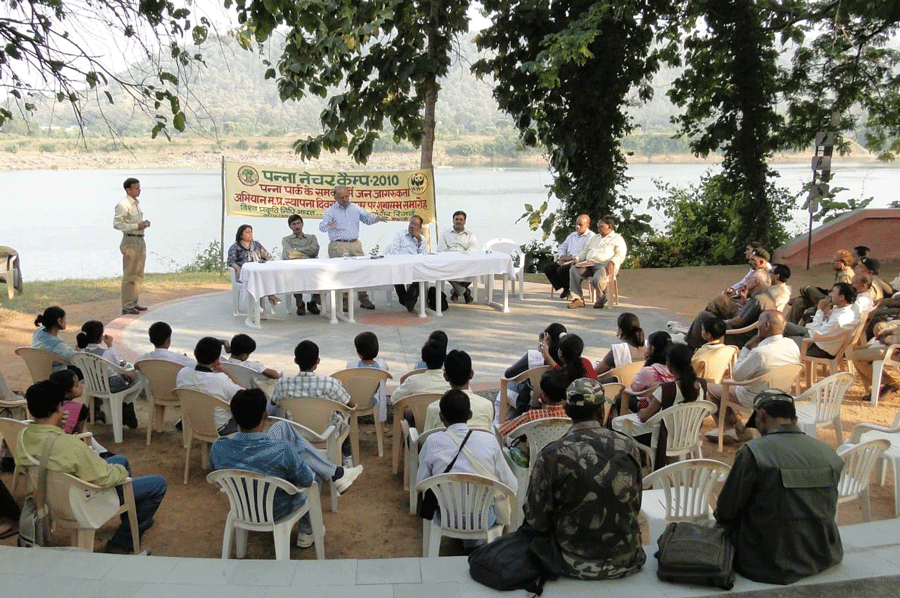Influence of Environmental Factors on Fertile Soil Yield
Introduction
Fertile land is a vital resource for agricultural productivity, which directly supports food security and the economy of a region. However, the productivity of fertile land is heavily influenced by various ecological factors, including climate, soil characteristics, water availability, biodiversity, and human activities. Productivity of fertile land is influenced by multiple ecological factors, with complex interactions between them. Climate, soil characteristics, water availability, biodiversity, and human activities all play crucial roles in determining land productivity. Water availability is a primary regulator of plant productivity, especially in arid and semi-arid ecosystems {Serafini et al.,2019).In temperate mesic grasslands, soil moisture availability interacts with nutrient supply to influence productivity. Under normal conditions, shoot productivity is primarily limited by soil nutrient supply, but water availability becomes the primary constraint during drought (Serafini et al.,2019).
Understanding the interplay between these factors is crucial for sustainable land management and agricultural practices. This article will explore how ecological factors impact the productivity of fertile land and the strategies to mitigate negative effects (Fig.1.)

1. Climate and Weather Patterns
Climate is one of the most significant ecological factors affecting and productivity. Temperature, rainfall, humidity, and sunlight significantly impact crop growth and yield across various regions and crops, as evidenced by multiple studies: Rainfall plays a crucial role in crop production, especially in rainfed ecosystems. In Dharmapuri District, India, analysis of 100 years of rainfall data revealed that 56.3% of months had normal rainfall distribution, while 34.1%were drought months. This information he ped identify available 120-day growing period from August to December for annual cropping (Parasuraman& Mani,2012). Similarly, in Khulna city, changes in rainfall patterns over four decades showed varying impacts on different seasons, affecting crop production (ArefinSiddikui & Nahida Sultana, 2024).The relationship between these factors and crop yield is not always straight forward. For instance, in Jodhpur district, western Rajasthan, rainfall positively influenced bajra. kharif pulses, and sesamum yields, while mean temperature had a negative impact. Mean relative humidity showed a weak influence on crop productivity (Vyas et al.,1985). In contrast. a study on maize cultivars found that number of leaves was most sensitive to rainfall, minimum temperature, and relative humidity, while plant height and leaf area were more responsive to maximum temperature and sunshine hours, respectively (Makinde et al.,2019). Optimal temperatures and adequate rainfall can enhance crop yields, while extreme weather conditions-such as droughts, floods, and heat waves – can lead to crop failure and soil degradation.
Temperature :
Temperature plays a crucial role in seed germination and early seedling growth across various crop species. Different crops have specific optimal temperature ranges for germination and growth, with extreme temperatures often inhibiting these processes. For lnstance, Medicagotruncatula showed distinct quantitative trait loci (QTLs) for germination at suboptimal(5 or 10ºC) and supra-optimal(20ºC) temperatures (Dias et al.,2010). Sophoradavidii exhibited maximum germination (30.67%) at a constant temperature of 20ºC (Wang et al.,2016).For Zostera marina, the optimal water temperature for seed germination ranged from 10 to 15ºC, while seedling growth was optimal between 20 to 25ºC (Abe et al.,2008) . Picnomonacarna seeds germinated over a wide temperature range from 5 to 35ºC with highest germination at 20ºC constant and 20/10ºC fluctuating temperatures (Nosratti et al.,2019).Some crops show adaptability to extreme temperatures. Fiber sorghum, typically requiring temperatures above 10ºC for germination, demonstrated high cold tolerance with 82.4% germination at 8ºC for certain cultivars (Patane et al., 2012). Similarly, many cover crop species were found to be adapted to summer sowing with relatively high optimal temperatures for germination, although some Fabaceae species were more sensitive to high temperatures (Tribouillois et al.,2016).
Rainfall
Rainfall patterns significantly impact crop health and yield, with both drought and excessive rainfall posing threats to agricultural production. Drought consistently decreases maize yield due to water deficiency and concurrent heat, with greater yield loss for rainfed maize in wetter areas (Li et al.,2019). Excessive rainfall can have either negative or positive impacts on crop yield, varying regionally. In cooler areas with poorly drained soils, excessive rainfall can decrease maize yield significantly, especially under high preseason soil water storage conditions (Li et al.,2019).The impact or excessive rainfall on crop yield remains less understood compared to drought effects. Observational evidence shows that excessive rainfall can reduce maize yield by up to -34% (-17± 3% on average) In the United States, comparable to the up to -37% loss caused by extreme drought (-32 ± 2% on average) from 1981 to 2016 (Li et al.,2019). In dry environments like West Africa, excessive soil water associated with heavy rainfall events can have detrimental effects on cowpea yields, particularly in areas with poorly drained soils (lizumi et al.,2023) .To mitigate the impacts of irregular rainfall patterns, various strategies can be employed. Effective crop planning with appropriate sowing time short duration crops, and high yielding drought-resistant varieties can help better utilize monsoon rain and reduce water stress (Manivasagam & Nagarajan, 2017). In arid and semi-arid regions with limited water availability, dry farming techniques and water harvesting methods can be implemented to cultivate drought-resistant crops (Feddes & Bastiaanssen, 1992).The development of crop· specific drought indices can aid in assessing moisture stress and guiding irrigation management decisions (Mcdaniel et al., 2017).
2. Soil Quality and Health
Healthy soil, rich in nutrients and organic matter, plays a crucial role in supporting robust plant growth through various mechanisms. Soil organic matter (SOM) is particularly important for maintaining soil quality, improving water-holding capacity, enhancing nutrient cycling, and reducing soil compaction (Reddy,2016). It also contributes to the development of healthy plants that are more resistant to pests, diseases, and drought stress. Soil microbiomes, Including bacteria and fungi, are essential for preserving soil health and promoting plant development. These microorganisms form symbiotic relationships with plants, aiding in nutrient uptake, pathogen defense, and root growth. For Instance, mycorrhizal fungi establish symbiotic associations with plant roots, enhancing nutrient and water absorption {Nichols,2008). Plant growth-promoting rhizobacteria (PGPR) colonize plant roots and positively affect plant growth and physiology by improving soil nutrient turnover (Ciftci et al.,2021). While organic matter additions generally increase microbial activity, they may not always result in more vigorous root systems. A study on Capsicum revealed that treatments reducing longer root systems produced higher crop biomass and yield, suggesting that the pattern of root development can provide insights into plant-microbe-soil interactions (Pandey et al.,2016).The Incorporation of biochar. especially when combined with compost and PGPR, has shown synergistic effects on plant growth and disease resistance for various crops (Das & Mitri,2024).
Soil Erosion :
Wind and water erosion significantly impact soil fertility and crop productivity by removing nutrient-rich top soil. This process leads to reduced soil organic matter (SOM), nutrient depletion, and decreased water retention capacity, ultimately affecting agricultural sustainability (Srinivasarao et al.,2021).Wind erosion can cause substantial soil loss, with studies showing that removal of 20 cm of topsoil can reduce grain yield by up to 53% (Larney et al.,2000). The loss of fine soil particles, particularly very fine sand and coarse silt, is most susceptible to wind erosion (Chappell & Thomas, 2001; Segovia et al.,2017). This selective removal of smaller particles results in the depletion of essential nutrients, especially nitrogen, as these particles are often nutrient-rich (Chappell & Thomas, 2001). The impact of erosion on soil productivity varies depending on soil type, climate, and management practices (Tanaka, 1990). While some studies have found that commercial fertilizer use can maintain crop yields in eroded soils, SOM levels may remain unchanged, Indicating that conventional tillage practices n semi-arid regions may not be sufficient for restoring erosion damage {Allen et al.,2011). However, other research has shown that applying livestock manure can be an effective short term solution for restoring soil productivity, Increasing grain yield by up to 158% In severely eroded soils (Larney et aL, 2000). To mitigate the effects of erosion on soil fertility and crop productivity, it is crucial to implement soil conservation practices, Improve technology transfer, and develop drought-resistant crop varieties (Srinivasarao et al.,2021).Monitoring and quantifying soil organic carbon (SOC) loss due to wind erosion is essential for understanding its impact on ecosystem productivity and developing effective management strategies (Yan et al.,2005).
Nutrient Depletion :
Continuous cultivation without proper nutrient replenishment can indeed lead to soil nutrient depletion and reduced productivity over time. This is a significant concern for sustainable agriculture and food security (Majumdar et al.,2016;Zahlr et al.,2018). Nutrient mining occurs when crop nutrient removal and losses exceed the soil’s inherent nutrient supply. Many farmers currently adopt inadequate and imbalanced nutrient management strategies, promoting nutrient depletion (Majumdar et al., 2016). In sub-Saharan Africa, for example, soils that have been cropped for generations have severely depleted inherent fertility, resulting in decreasing crop yields (Bayu et at, 2005). However, there are effective strategies to maintain and improve soil fertility. The 4R Nutrient Stewardship Principles (right source, rate, time, and method) can help reduce nutrient mining (Majumdar et al., 2016). Integrated nutrient management approaches, combining Organic Inputs like animal manure with mineral fertilizers, show promise for resource-poor farmers (Sayuet al.,2005;Osman,2018). Other beneficial practices include crop rotation, cover crops, conservation tillage, and liming acidic soils (Osman,2018). Proper soil testing and nutrient management planning are crucial for quantifying crop nutrient requirements and soil nutrient-supplying capacity (Havtin,2020). Soil Contamination: Continuous use of chemical fel’t11izersand pesticides In agriculture can indeed lead to soil contamination and disrupt the natural microbial balance. These agrochemicals accumulate in the soil over time, causing several adverse effects on so l health and ecosystem functioning (Shadouria et al.,2020; Kaushik et al., 2018). The accumulation of chemical fertilizers and pesticides in soil negatively impacts soil fertility, water quality, and native microorganisms, particularly beneficial species like cyanobacteria in wetland rice cultivation (Kaushik et al.,2018). These contaminants can persist in the soil, leading to the deterioration of physicochemical and biological attributes of the agricultural ecosystem (Bhadourla et al.,2020). Moreover, they can biomagnify at different trophic levels, posing serious hazards to human health and the environment (Bhadouria et a ., 2020;Hossain et al., 2022). To address these Issues, alternative approaches such as organic farming methods and the use of biofertilizers and biopesticides are being promoted (Singh et al.,2019; Singh et al.,2020). These eco-friendly practices can help restore soil health, improve microbial diversity, and enhance nutrient cycling (Parewa et al.,2021;Singh et al.,2020). For instance, organic farming methods have shown to increase soil carbon and nitrogen content, enhance soil fertility, and improve crop productivity while being cost effective and environmentally sustainable (Kai & Kubo,2020; Singh et al., 2020).
3. Water Availability and Management
Water available is indeed a critical factor for plant growth and land productivity, significantly impacting photosynthesis and nutrient transport in crops. Research has shown that water scarcity is a major limiting factor for crop productivity, especially in arid and semi-arid regions (Chtouki et al.,2022; Nimah,2010). Adequate water supply is essential for maintaining optimal stomatal conductance, chlorophyll content, and photosynthetic efficiency, which directly influence biomass accumulation and nutrient uptake (Chtouki et al.,2022). Interestingly, while water is crucial, its interaction with other factors such as nutrient availability and fertilizer form can significantly affect crop performance. For Instance, the effectiveness of polyphosphate fertilizers was found to be greatly reduced under water stress conditions, whereas orthophosphate fertilizers maintained stable positive effects on plant growth parameters (Chtouki et al.,2022). Additionally, nanotechnology-based fertilizers have shown potential in improving water use efficiency and helping plants survive challenging environmental factors such as drought (Al· Juthery et al.,2021).
Irrigation :
Effective irrigation systems can significantly improve land productivity in regions within sufficient rainfall, but they must be carefully managed to maximize water use efficiency. Supplemental irrigation, when combined with rainwater harvesting techniques like ridge-furrow systems, can substantially increase crop yields and radiation use efficiency in semi-arid regions (Aliet al.,2017; Aliet al., 2018). For instance, the ridge-furrow system with 200 mm simulated rainfall and 150 mm deficit irrigation increased grain yield by 19% and water use efficiency by 76% compared to traditional flat planting in semi-arid China (Ali et al.,2017). Maximizing water productivity rather than yield per unit of land may be a more appropriate strategy for dry farming systems where water is the most limiting resource (Oweis & Hachum, 2005). This approach calls for revising conventional water management guidelines to ensure maximum water productivity. Small-scale irrigation systems and water harvesting techniques can be more affordable and effective in dryland developing countries compared to large-scale Irrigation projects (Abebe,2021).
Water Scarcity :
Water scarcity is indeed a major limiting factor for crop production, particularly in arid and semi-arid regions, with significant impacts on food security and livelihoods (Man-Hong et al.,2020: Shi et al.,2022). Drought can severely affect plant productivity by impacting carbon gain, canopy development, and reproductive structures (Davies & Wilkinson,2012). This leads to reduced crop yields, economic losses for farmers, and food shortages in affected communities (Eze et al.,2022; Shi et al.,2022). Some research suggests that lack of water itself may not always be the primary constraint to crop growth in drought-prone areas. Poor rainwater partitioning and low plant water uptake capacity can reduce on-farm grain yields to just 1/10th of potential yields, indicating opportunities for improvement through better and water management practices (Rockstrom&Falkenmark, 2000). The concept of “technological drought” highlights how crop failures or reduced yields can result from an inability to supplement water due to lack of irrigation technology or poor water management, rather than just meteorological drought (HaqueMondolet al.,2022). To address these challenges, various strategies have been proposed. These include improving soil organic carbon content to reduce yield losses during droughts, optimizing irrigation water productivity through crop variety selection and location-specific adaptations (Heinz et al., 2024), and utlilizing plant growth-promoting rhizobacteria to enhance crop growth under environmental stress (Ojuederie et al., 2019). Sustainable intensification of agriculture, along with novel crop management techniques and genetic improvements, may help mitigate the impacts of water scarcity on crop production and food security in drought-prone regions (Davies & Wilkinson, 2012).
Water Quality :
Water shortages and poor water quality due to pollution can significantly impact soil health, crop productivity, and food safety. The use of contaminated water for irrigation introduces harmful substances Into the soil and crops, leading to various adverse effects (Lu et al., 2015;Suresh &Nagesh,2015). Irrigation with polluted water can cause excessive accumulation of salts in the root zone, affecting crop yield, quality, and choice of crops that can be grown (Suresh &Nagesh, 2015). Heavy metals, industrial pollutants, and pesticides in contaminated water supplies can accumulate in soil and crops, ultimately entering the food chain and posing serious health risks to humans (Lu et al.,2015; Smith,2023). For instance, a study showed that maize crops irrigated with polluted river water experienced a 25% decrease in yield compared to those irrigated with borewell water (Suresh &Nagesh, 2015). To address these challenges, various measures can be implemented. These include efficient irrigation water management, integrated pest management, comprehensive nutrient management planning and conservation agriculture (Wato, 2020). Additionally, the use of zeolites as soil ameliorants can improve soil properties, alleviate heavy metal toxicity, and enhance fertilizer and water use efficiency (Mondal et al.,2021).
Phytoremediation and phyto augmentation technologies also show promise in cleaning up contaminated soil and waste water (Kumar et al.,2020). Ultimately, integrated policies addressing soil and water pollution are crucial for achieving food safety and sustainable agricultural production (Lu et al.,2015).
4. Human Activities and Land Management Practices: Human activities have indeed significantly impacted the productivity of fertile land through various mechanisms. Deforestation, industrialization, and improper agricultural practices are major contributors to land degradation and loss of soil fertility. Deforestation, driven by the need for agricultural land, urban expansion, and resource extraction, has led to a significant reduction in forest cover globally (Forest Degradation Around the World,2020). This practice not only reduces vegetation but also impacts forest structure, species composition, and ecosystem functions, ultimately decreasing forest productivity (, 2020;Raj et al., 2022). Agricultural expansion, in particular, has radically changed natural landscapes through steppes plowing, deforestation, and the construction of irrigation systems (Bandutin & Bandurina, 2021). While agriculture is a major cause of land degradation, it is also severely impacted by it. Inappropriate agricultural practices, Including excessive tillage, overuse of inorganic fertilizers, poor irrigation techniques, and inadequate crop res due management, account for nearly 40% of land degradation in India alone (Bhattacharyya et al.,2023). These practices contribute to soil erosion, nutrient depletion, and loss of soil biodiversity, further reducing land productivity (Abebaw,2019; Kumar et al., 2022)

Strategies for Sustainable Land Ptoductivity Soil conservation practices are crucial for addressing ecological challenges in agriculture. Conservation Agriculture(CA) principles, including minimum soil disturbance, permanent soil cover, and crop diversification, have proven effective in preserving soil health and enhancing productivity (Kass.am et al., 2014; Kumar et al., 2023). These practices reduce soil erosion, improve water retention, and promote biodiversity.
Conservation tillage and no-till systems have been successful in controlling land degradation and maintaining soil mulch cover (Kassam et al.,2014). Water management strategies play a vital role in sustainable agriculture. Water smart farming techniques, such as precision irrigation, rainwater harvesting, and alternate wetting and drying technology, can significantly reduce water consumption and improve crop yields (Frimpong et al.,2023). In arid regions, revitalizing oasis agriculture through precision irrigation and water conservation methods is essential for sustaining biodiversity and ecosystems (Dhawi & Aleidan, 2024).Organic farming and integrated soil fertility management (ISFM) contribute to soil health improvement and reduced environmental impact. These practices minimize the use of synthetic inputs, preserve biodiversity, and promote natural pest control (Adedibu, 2023; Diop et al., 2022). However, it’s important to note that some organic farming systems may remain intensive and specialized, requiring further diversification to achieve true sustainability (Rosati et al.,2020). Agroforestry and crop diversification offer transformative potential for sustainable agriculture. Integrating trees with crops and/or livestock can enhance soil fertility, improve microclimatic conditions, sequester carbon, and protect biodiversity (Arshad et al.,2024; Lebrazi & Fikri Benbrahim,2022).
Agroforestry systems, particularly those incorporating tree legumes, c.an intensify nitrogen availability in the soil and Increase crop y elds (Lebraz & Fikr ·Benbrahim,2022). Crop diversification, including the integration of pulses in CA systems, contributes to resource conservation, soil health improvement, and sustainable crop production (Kumar et al., 2023).
Conclusion :
The productivity of fertile land is influenced by a complex Interplay of ecological factors, including climate, soil health, water availability, biodiversity, and human practices. Understanding these factors and their interactions is essential for developing sustainable agricultural practices that can maintain and enhance land productivity. By adopting strategies that promote soil conservation, water management, and biodiversity, we can ensure the sustainable use of fertile land for future generations. Sustainable agricultural practices, such as conservation agriculture (CA) and crop diversification, play a crucial role in maintaining long term Soil fertility and ecosystem health. These approaches not on y enhance soil structure and nutrient cycling but also improve water retention and reduce erosion, contributing to overall and productivity. Furthermore, the integration of diverse crops, particularly legumes like pulses, can provide additional benefits such as nitrogen fixation and increased microbial activity In the soil.











